By Vince Mancuso, Storage.com
Placing your baby items in a storage unit for future use clears out some of the clutter in your home while giving you the opportunity to get the most value out of some of the more expensive pieces of baby gear through future use. Storage facilities can offer parents affordable room for all their items with security and features to keep everything safe while in storage.
To help parents know how to properly pack and store clothes, toys, and other essential equipment prior to placing them in self storage, Storage.com spoke with Crystal Sabalaske, professional organizer and owner of Cluttershrink for more than a decade. A mother of two, Crystal is also a contributor to Hint Mama, a site dedicated to providing helpful consumer tips for mothers.
Feel free to skip ahead to any of the following categories:
How to Prepare Baby Clothes for a Storage Unit
How to Package Baby Clothes in a Storage Unit
How Short-Term Self Storage Benefits Larger Baby Gear
How to Store Baby Swings and Rockers in a Storage Unit
How to Store a Baby Crib in a Storage Unit
How to Store Smaller Baby Equipment in a Storage Unit
How to Store Baby Toys in a Storage Unit
How to Organize Baby Equipment in a Storage Unit
How to Care for Baby Equipment that Has Been in a Storage Unit
HOW TO PREPARE BABY CLOTHES FOR A STORAGE UNIT
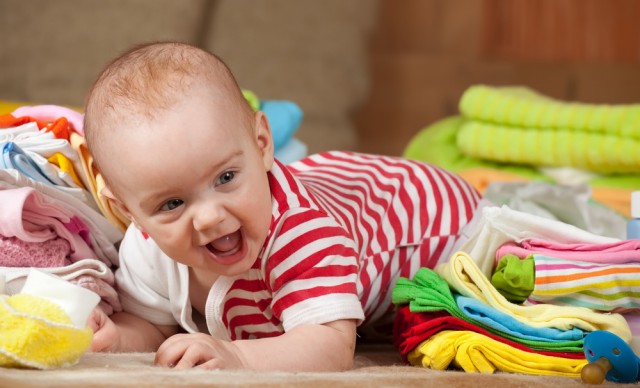
One of the most common items handed down between children is clothing. For those parents wanting to save clothing for future children, Crystal recommends a few simple steps, starting with laundering the clothes with unscented laundry detergent.
“The fragrance from scented laundry detergent can attract bugs and rodents,” says Crystal. “Some people feel that unscented laundry detergents don’t clean as well as scented detergents, although I’ve never had an issue.” For those who feel they must wash with scented detergent, she says you should still rewash everything with unscented detergent prior to storage to avoid pests from damaging the clothing.
Once clean, Crystal says to fold items to minimize how much space they take up, then sort the clothes by gender and size. You should also make unisex clothing it’s own category.
“If you are saving baby clothes to preserve ‘precious memories’ or to pass onto grandchildren, only keep the most treasured items,” Crystal adds. “Most people don’t have the space to keep everything.” For those who are planning for more of a long-term storage solution, she says to sort the clothing by each child, not by gender or size.
Again, it’s important to make sure all items are cleaned with unscented detergent. While some storage facilities may offer free pest control, it’s not always an option. Keeping your baby clothes clean and unscented prior to placing in self storage can help prevent bugs and rodents from being attracted to your unit.
HOW TO PACKAGE BABY CLOTHES IN A STORAGE UNIT
Once your clothing is clean, folded, and sorted, place them in clearly labelled containers. Crystal recommends labeling containers by contents such as clothes, blankets, or bibs; genders of boy, girl, or unisex; and sizes. Having things clearly labeled will make it easier to get the exact item, gender, and size you need for your next child. As for what type of container to use, she recommends a plastic tote or bin with a lid.
Crystal adds that there are acid-free boxes that can be used when storing more treasured items of clothing. As all items have a the potential to yellow over time, in addition to plastic storage containers releasing gases over the course of years that can add to discoloration, it is something to consider. “If items will be in storage for years, and we’re talking many years, there are acid-free storage boxes as well.”
However, she warns that acid-free boxes shouldn’t be stored in humid environments, as the moisture can promote mold and mild growth that can break down the boxes. A good compromise would be wrapping items in acid-free paper before placing them in plastic bins or finding a storage facility with climate-controlled storage units, which maintain a moderate temperature and humidity level. “Don’t fret over using plastic storage containers,” she says. “I’ve had some items in storage for seven years already and haven’t had any issues.”
Another storage container to avoid in some areas are vacuum-sealed bags, which are typically used to save space. However, Crystal doesn’t recommend these space bags due to moisture.
“Space bags are recommend only if you are storing them in places that aren’t prone to humidity,” she says. “Clothes actually need room to ‘breathe’ and vacuum seal bags don’t allow for that.” Clothes in a vacuum-sealed bag that allow no air flow in an area with high humidity can result in mold or mildew growth, which will damage the clothing. “However, for short-term storage (1-3 months) in moderate temperatures of 60-75 degrees, vacuum-seal bags would be fine.”
For anything longer than a few months or if you’re storing in regions with fluctuating seasonal temperatures and humidity levels, Crystal says it makes sense to invest in a climate-controlled storage unit. “The cost to rent such a unit will be cheaper than replacing damaged items,” she adds. These storage units will keep your baby clothes at a steady temperature and humidity level, allowing them to breathe throughout their time in storage.
TIPS FOR FINDING A GOOD DEAL
ON A STORAGE UNIT
HOW SHORT-TERM SELF STORAGE
BENEFITS LARGER BABY GEAR
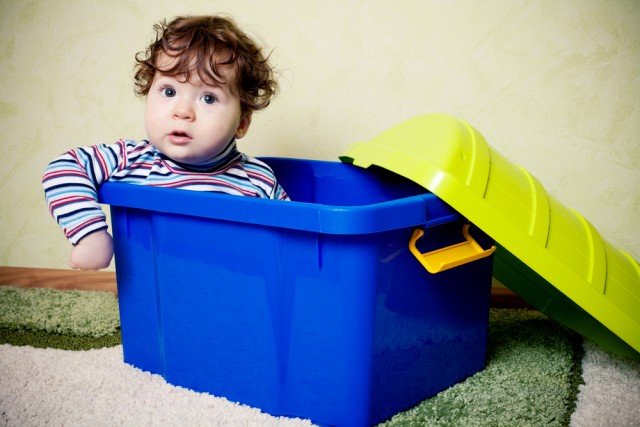

While baby clothes can fit in smaller 3×5 or 5×5 storage units, self storage does offer larger units that can hold bigger pieces of baby equipment. As Crystal puts it, “anything big” that your baby uses can be considered for self storage. “Cribs, bassinets swings, high chairs—because space limitations often determine what can be saved,” she says. “Assembled items are also difficult to stack, and therefore take up a lot of floor space.”
When storing these larger items, it’s important to know the materials used, so you can determine whether or not you’ll need climate control. “It’s not as much of a concern for some of the larger plastic items as it is for wood items,” Crystal says. Plastic items are more resistant to mold, mildew, and warping from temperature and humidity, whereas wooden parts can warp through fluctuating seasonal temperatures and absorption of water in the air. So, if you live in and plan to use self storage in a Midwestern city such as Chicago, which sees frigid winters and hot, humid summers, use a climate-controlled unit to prevent any warping from occurring.
Additionally, as many of these items can be expensive, Crystal recommends finding a storage facility with strong security features. These features should include electronic gate access, video surveillance, and making sure you keep the unit locked.
“Many people want to store pieces of baby equipment for a future child,” Crystal says. “If you plan to have a child within the next few years, this may make sense. However, if you plan on waiting several years, I would not recommend it.” Her reasoning for this warning is the frequent changes in safety regulations as well as the fact that many larger products are subject to safety recalls and redesigns.
One item in particular that should only be used in short-term storage is a car seat. “Car seats expire after 5 years, regardless of whether or not the car seat was used often,” Crystal says. “Even if it was never involved in an accident.” For this reason, she adds, that car seats are not recommended for reuse or storage unless children are very close to each other in age. However, baby equipment such as swings, rockers, or cribs are often saved for reuse in a year or two.
HOW TO STORE BABY SWINGS AND ROCKERS
IN A STORAGE UNIT


“If possible, wash any fabric parts in a washing machine and air dry,” Crystal recommends for baby swings or rockers. “If that is not possible, wash the surface and air dry in the sun/heat to disinfect.” While cleaning, she says to uses a child-safe cleaner to wipe all hard surfaces and make sure everything is dry before placing in storage to prevent mold and mildew growth on fabrics or rust on metal components.
“In some cases, depending on the length of storage time required, it may be easier to cover the item with a white cotton sheet than it is to dissemble the items,” she says. However, she adds, space constraints may necessitate taking the item apart. In such a case, she recommends using a plastic bin, if large enough, for the piece.
Much like storing clothing, make sure the container is clearly labeled. This will save you time and hassle if you should need to retrieve a particular piece of baby equipment.
HOW TO STORE A BABY CRIB IN A STORAGE UNIT
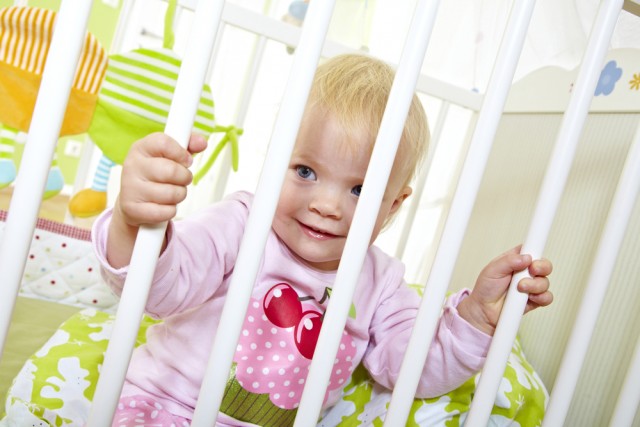

Baby cribs are one of the items Crystal recommends to investigate for safety regulations prior to putting it into storage. “My children are less than 2 years apart, and during that time, the crib safety guidelines changed, so I was unable to use my daughter’s crib for my son,” she says. “The distance between slates, materials used to finish the wood on cribs, and the use of drop-down sides are reasons cribs quickly become outdated.”
If you do plan to keep your crib, Crystal says the first step is to take a picture of how it looks assembled before breaking it down. As you take it apart, she says designate each piece with categories such as “right side” or “back,” with a tie-on tag or label, as a sticker or tape can leave a residue. You should also collect hardware in a small plastic bag, labeling each bag with a permanent marker.
Once you have all the hardware parts, Crystal recommends placing them along with a picture of the crib fully assembled and assembly instructions—if available—in a plastic container the size of a shoe box. If possible, secure this box to a larger piece of the crib or place in a larger box with other items you’d need for the crib, such as blankets, sheets, etc. and have the box clearly labeled, “Contains crib parts.”
For your mattress pad and mattress, Crystal recommends machine washing the pad and surface wiping the mattress with a child-friendly cleaner. If your mattress is fabric, she adds that you should vacuum the mattress and wipe down with a child-friendly solution or disinfectant wipes before storage to prevent mold and mildew growth. Additionally, fabric mattresses should be wrapped in plastic or placed in a mattress storage bag, which she says can be purchased at many self storage facilities or stores that sell moving boxes.
Once cleaned and wrapped, the mattress pad can be stored in the same storage box as the crib hardware or linens for organizational purposes, and, when placed in storage, keep the mattress flat to maintain its integrity.
HOW TO STORE SMALLER BABY EQUIPMENT
IN A STORAGE UNIT
For other odds and ends of baby equipment, Crystal recommends similar steps as taken for cribs or swings. For instance, she says a high chair is worth keeping if you’re planning on having another child in a few years, as they too have safety regulations that are prone to change.
“High chairs should be treated the same as baby swings. Clean all surfaces, air dry, disassemble if space is needed, or cover in a white cotton sheet or cloth if keeping assembled,” she said. Additionally, plastic components in a high chair or other items can be labeled using painter’s tape. “It’s best to store the user manual/instructions with each item, and it helps to put the instructions in a plastic bag and tape them directly to the item.”
Changing tables can be treated like cribs, as they are also prone to warping, moisture, and mold damage if left untreated. She says to take a picture of the assembled item, then disassemble the changing table and make sure to clean the surface and dry each piece. Again, label all items and box the parts with a picture of the assembled table and instructions. Crystal adds you can cover it with a white cotton sheet to prevent dust build up, and you can store any changing pads inside a plastic container.
All other items or parts for baby items such as bouncy seats, portable booster seats, and others should be disinfected and can be stored in an extra large, 50-gallon totes that are available at most major hardware stores. Basic disinfecting and storing in such large containers will keep things aired to prevent mold and mildew growth on certain surfaces.
There are some items Crystal said should not be stored, such as bath tubs. “Bath tubs tend to get moldy due to the non-slip bumps and stickers on the bottom and inside of the tub,” she says. “If there are any signs of resistant mold, do not keep or store a tub.”
Other items or components to consider are batteries in electronic items. Crystal advises removing all batteries prior to storage to prevent acid leaks that could damage your items. Batteries, if left in high heat, can swell, causing cracking and damage, which can lead to irreparable damage to your items as well. If you’re storing such an item with a non-removable, rechargeable battery, use a climate-controlled storage unit to maintain the temperature inside the unit.
HOW TO STORE BABY TOYS IN A STORAGE UNIT
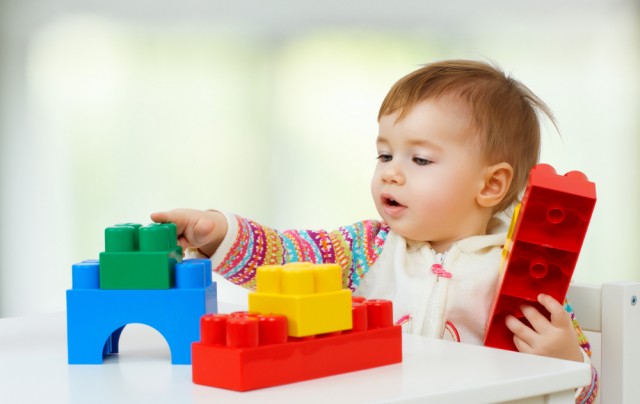

“The toys that most people keep are the classics,” Crystal says. “Legos, Little People, Tinker Toys, Matchbox cars, Barbies, etc.” She says all saved toys should be cleaned prior to storage, and most can be disinfected with a simple bleach/water solution. “Others, like Legos and other hard, solid plastics, can be put in a small mesh bag and run through the top rack of a dishwasher,” she adds. Cleaning will help prevent bacteria from spreading as well as from certain molds or mildews from growing.
However, Crystal says to inspect any toys your previous child may have chewed on. Look for cracks or chew marks, and if there are any present, it’s best to not save the toy as there is a possibility of bacteria and germs remaining in those cracks and crevices. She also says musical toys and rattles are best left out of storage as they are regularly updated with safer materials and more features. “These are typically the toys that should not be saved because they are so easily replaced and not often expensive.”
For those looking to save stuffed animals, whether for future children or as a memento for your children when they’re older, Crystal says many of these toys can be machine washed and dried on the low cycle or left in the sun to dry. “But if a stuffed animal is not washer-friendly,” she adds, “you can put the stuffed animal in a sealed plastic bag in the freezer for 24 hours to ‘disinfect’ it.”
Once all toys, plastic or stuffed, have been clean and disinfected, they can be placed in a plastic storage tote. As all toys need to breathe to prevent mold or mildew growth and damage, totes allow for the space for air to flow.
“I do not recommend storing any plastic or wood toys in a storage unit prone to high or low temperatures and humidity,” Crystal says. Plastic toys can break down in the heat, have components melt, leech chemicals into the air, and become brittle and crack when exposed to extreme temperature fluctuations. Again, to prevent such damages, use a climate-controlled storage unit if you live in regions that have extreme seasonal weather, as the maintained temperature and humidity level will prevent weather-related damage to your baby toys. Even fabric toys can benefit from climate-control has it helps prevent moisture from getting in the fabric, causing mildew growth and smells to develop.
BROWSE, COMPARE, AND RESERVE
A STORAGE UNIT RIGHT HERE!
HOW TO ORGANIZE BABY EQUIPMENT IN A STORAGE UNIT
Crystal says there are some simple steps to take to keep your baby gear organized within your storage unit. For instance, store like-items together and keep the items you will need sooner closer to the front of the unit. Another tip she gives is using an old sheet or moving blanket to cover furniture. Not only does this help avoid dust and other damage from any potential dings, but she says this will allow you to stack plastic bins on the more sturdy pieces of furniture. Stacking items will get the most use out of the vertical space in your storage unit, which means you can use a smaller unit and save some money.
“Always leave a few feet in the front and middle of the storage unit if possible,” she adds, “So you have some room to move things from side to side if you should need to access something toward the back of the unit.” Lastly, Crystal recommends keeping an inventory of what you have stored in the unit, and if possible, have the inventory include notes on where you stored each item within the unit, such as in the “back-right corner.”
HOW TO CARE FOR BABY EQUIPMENT THAT HAS BEEN
IN A STORAGE UNIT
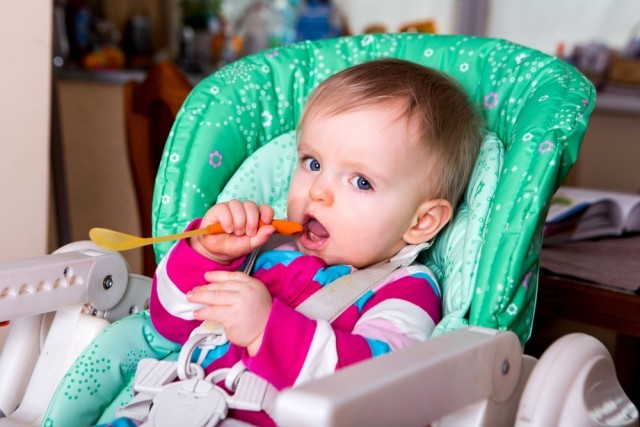

“I always recommend visiting the storage facility at least once a month to check on items,” Crystal says. When checking up on your baby equipment, look for possible issues such as leakage within the unit, any odd spills in or near your unit, look for pests, and check your items in general.
When the time comes that you do need your baby gear again, she recommends giving all items a look over for any evidence of bugs or rodent droppings, and be sure to dust, disinfect, vacuum and/or air out all items before use. “Specifically for baby clothes and fabric items,” she notes. “Rewash shortly before use.”
Rewashing will help protect your newest baby’s sensitive skin from any rashes or irritations from dirty or rough fabrics, just as clean toys, cribs, and swings will help prevent any sickness. Also, for pieces that need to be reassembled, make sure that wood and plastic components are still sturdy and have not suffered any warping or damage if you did not use a climate-controlled unit. Warping can harm the structural integrity of a crib, making it a risk for your child.
Using self storage on baby items for your next child can help lessen the stress of finding and purchasing new equipment like when you had your first child. After all your favorites are cleaned, assembled, and thoroughly checked, enjoy your newest addition to your family!
Are you using self storage to keep your favorite baby items safe? Let us know what you’re storing in the comments below!
***
All images have either been provided by a listed organization or are licensed under the Creative Commons.





